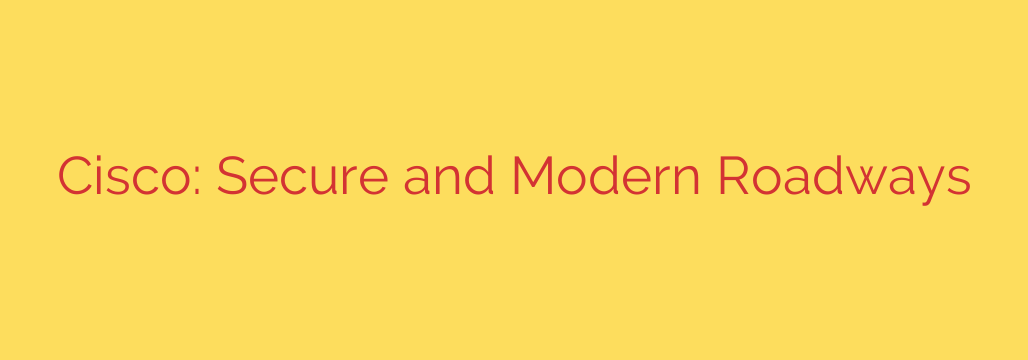
The Future of Transportation: Building Secure and Intelligent Roadways
Every day, millions of commuters face the same challenges: traffic congestion, unexpected delays, and the risk of accidents. Our traditional roadway infrastructure, designed for a different era, is struggling to keep up with modern demands. The solution lies not in simply building more roads, but in making them smarter. By integrating advanced technology into our transportation networks, we can create a future with safer, more efficient, and more reliable travel for everyone.
Welcome to the world of Intelligent Transportation Systems (ITS), a transformative approach that is reshaping how we manage our roads. At its core, ITS connects every element of our transportation ecosystem—from traffic signals and road sensors to vehicles and public transit—into a single, cohesive network. This connectivity allows for the collection and analysis of real-time data, providing unprecedented insights into traffic patterns and road conditions.
The Transformative Benefits of Smart Roadways
Moving beyond outdated, pre-programmed traffic signals, smart roadways leverage the power of the Internet of Things (IoT) to create a dynamic and responsive environment. By deploying a network of cameras, sensors, and communication modules, transportation authorities can unlock significant advantages.
- Reduced Congestion and Improved Traffic Flow: Smart systems can analyze live traffic data to adjust signal timing dynamically, reroute drivers around accidents, and optimize traffic flow through busy corridors. This means less time spent in traffic, lower fuel consumption, and reduced carbon emissions.
- Enhanced Public Safety: Connected technology enables instantaneous accident detection and automated alerts to emergency services. By providing first responders with precise location data and real-time video feeds, response times can be dramatically reduced. Furthermore, smart systems can warn drivers of upcoming hazards, such as ice on the road or debris from an accident, preventing further incidents.
- Smarter, Data-Driven Urban Planning: The wealth of data collected from an ITS network is invaluable for city planners. By analyzing long-term traffic patterns, cities can make more informed decisions about infrastructure investments, road design, and public transportation routes, ensuring our cities grow more efficiently and sustainably.
The Critical Challenge: Cybersecurity for Connected Infrastructure
While the benefits of intelligent roadways are clear, connecting our critical transportation infrastructure to the internet introduces a new and significant set of risks. Every connected sensor, camera, and traffic controller represents a potential entry point for malicious actors. The consequences of a cyberattack on a transportation network could be catastrophic, ranging from gridlock and economic disruption to life-threatening situations.
As we build these sophisticated systems, cybersecurity cannot be an afterthought—it must be a foundational component. The sheer scale of these networks creates an expanded attack surface, where a single vulnerability could be exploited to compromise the entire system. Protecting this digital infrastructure is just as important as maintaining the physical roads themselves.
Actionable Steps for Securing Modern Roadways
To build a truly resilient and secure smart roadway system, transportation agencies must adopt a proactive, defense-in-depth security strategy. This involves implementing multiple layers of protection to safeguard against a wide range of cyber threats.
- Implement a Zero-Trust Security Model: The foundational principle of a zero-trust architecture is to “never trust, always verify.” This means that no device or user is automatically trusted, regardless of its location on the network. Every connection request must be authenticated and authorized, significantly reducing the risk of unauthorized access.
- Utilize Network Segmentation: Dividing the transportation network into smaller, isolated segments is a crucial security measure. If one segment is breached, segmentation prevents the attacker from moving laterally to compromise other parts of the network, such as the traffic signal control system or emergency alert platforms.
- Deploy Advanced Threat Detection and Response: It is not enough to simply build walls; agencies must have visibility into what is happening on their network at all times. This requires deploying advanced tools that can continuously monitor network traffic for suspicious activity, identify potential threats in real time, and enable a rapid response to contain and neutralize them.
- Ensure End-to-End Data Encryption: All data transmitted across the network—from a roadside sensor to a central command center—must be encrypted. This ensures that even if data is intercepted, it remains unreadable and useless to unauthorized parties.
The journey toward fully intelligent and automated transportation systems is well underway. These advancements promise a future with smoother commutes, safer streets, and more sustainable cities. However, realizing this vision depends entirely on our ability to build these systems on a secure and resilient foundation. The road ahead requires a firm commitment to integrating robust cybersecurity into every layer of our modern transportation infrastructure.
Source: https://feedpress.me/link/23532/17119695/secure-and-modernize-your-roadways-with-cisco








